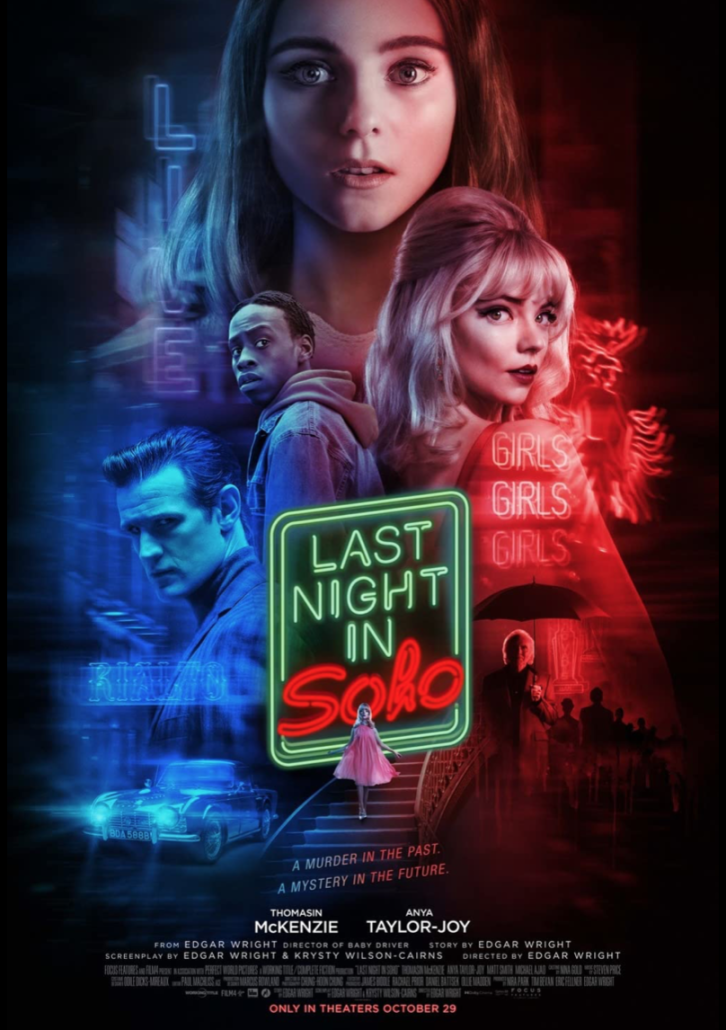‘Last Night in Soho’ is horrifyingly riveting

Warning: This review contains spoilers.
Directed by Edgar Wright, “Last Night in Soho” closely starts off like the story of every chick flick: A young, eager girl named Eloise (Thomasin McKenzie) moves to the big city — in this case, London — to pursue her dreams of becoming a successful fashion designer. This time, however, the girl can see ghosts. Coupled with Eloise’s mysterious nighttime trips to the 1960s through the life of a young aspiring starlet Sandie (Anya Taylor-Joy), “Last Night in Soho” is eerie, haunting (literally) and a thrill ride of a story.
It’s fascinating how subversive the narrative is. Just when one might think it’s one of those heartwarming coming-of-age films, the film quickly shows it’s anything but. While on the way to Eloise’s school, for example, what initially seems like a friendly and well-meaning taxi driver begins making offhand sexual remarks about Eloise. As Eloise becomes visibly uncomfortable, the taxi driver hints that he might stalk her. Eloise ends up getting off the cab early and hiding behind a shelf in a local grocery store, peeking to see if the taxi has left.
At another moment, a romantic encounter between Eloise and her classmate John (Michael Ajao) ends up being one of the most terrifying moments in the film as Eloise simultaneously witnesses a visceral scene of violence from Sandie’s past. There’s a lot of flickering back and forth between the past and the present. As Eloise becomes more invested in Sandie’s narrative, she soon discovers that venturing into the 1960s isn’t only limited to her trips in the nighttime.
Of course, the darker elements of the film don’t end there. The initial moments of the time travel feel optimistic, like Eloise might have something to learn from Sandie in the quaintness of the past. Eloise dyes her hair blonde just to look like Sandie and, inspired by Sandie’s star quality, begins gaining confidence in herself and her designs. Yet “Last Night in Soho” quickly takes a swerve into murder mystery territory as Eloise suspects Sandie’s manager Jack (Matt Smith) may have been involved in Sandie’s purported violent demise.
The shine and glamour of Eloise’s first visit quickly dissipates, and she must piece together the truth of what really happened to Sandie – all the while she’s haunted by the ghosts of Sandie’s past, courtesy of Eloise’s special ability.
When Eloise navigates the city, so does the audience. This connection is done in the most engaging way, where the viewer is looking at the setting just as Eloise is. Soho, as the site of tension, is arguably the most central character. For Eloise, the city is both a source of inspiration and an antagonist. There’s an unnerving life to the truths that emerge about Sandie and Soho. Slowly, the city’s two identities begin to merge just as the lives of Eloise and Sandie do.
Taylor-Joy is positively charismatic as Sandie, an initially self-assured and unruffled performer swept up in London’s destructive quality. Similarly, Taylor-Joy loses herself and adopts her characters’ grit as she chases a dream that seems so far away. She performs as an entertainer with an emotional complexity that’s difficult to mimic. The fashion is beautiful and mesmerizing, and it’s no surprise that Sandie’s outfits become the inspiration for Eloise’s own designs. McKenzie, too, is compelling as the wide-eyed and uniquely relatable ingénue who doesn’t feel like she belongs with the other girls at her school. Sandie seems like a dreamlike catalyst for Eloise’s self-discovery, but she instead becomes a nightmare.
The best part about “Last Night in Soho” is the way that these two characters thematically parallel one another: It’s not only ghosts from the past that haunt the present but dreams and deeds. This is rendered stunningly in the frazzled colors, cinematography and editing that all shed light on the two characters’ decline.
Wright’s use of music is gripping and enchanting all at once, evoking a degree of nostalgia but also foreboding for the narrative (In this regard, Taylor-Joy’s special rendition of the 1964 Petula Clark song “Downtown” for the movie is a major highlight). It’s unfortunate that the film loses those qualities amid the consistent use of shock value that becomes more tiring than thrilling. Many jump scares are used that could be eliminated for the sake of grounding the film in more narrative clarity.
In that sense, “Last Night in Soho” tries to do a little too much. Near the end, there’s an uninspired montage that feels like the “kill count” of a slasher film. Coupled with Eloise’s attempts to find belonging in fashion school, the supernatural and psychological drama aspects often get tied up in knots and are difficult to unravel. A few logistical gaps aren’t given enough explanation. The storyline about Ellie bearing a social stigma for her family trauma, for example, is briefly mentioned throughout the film but doesn’t really flesh out her character, nor does it illuminate her deterioration throughout the film as much as her preoccupation with Sandie does.
Still, the film doesn’t disappoint. Watching “Last Night in Soho” is like spending an exciting and brilliant night in the city. Sure it’s sometimes dizzying and disorienting, but you’ll never want it to be your last.

